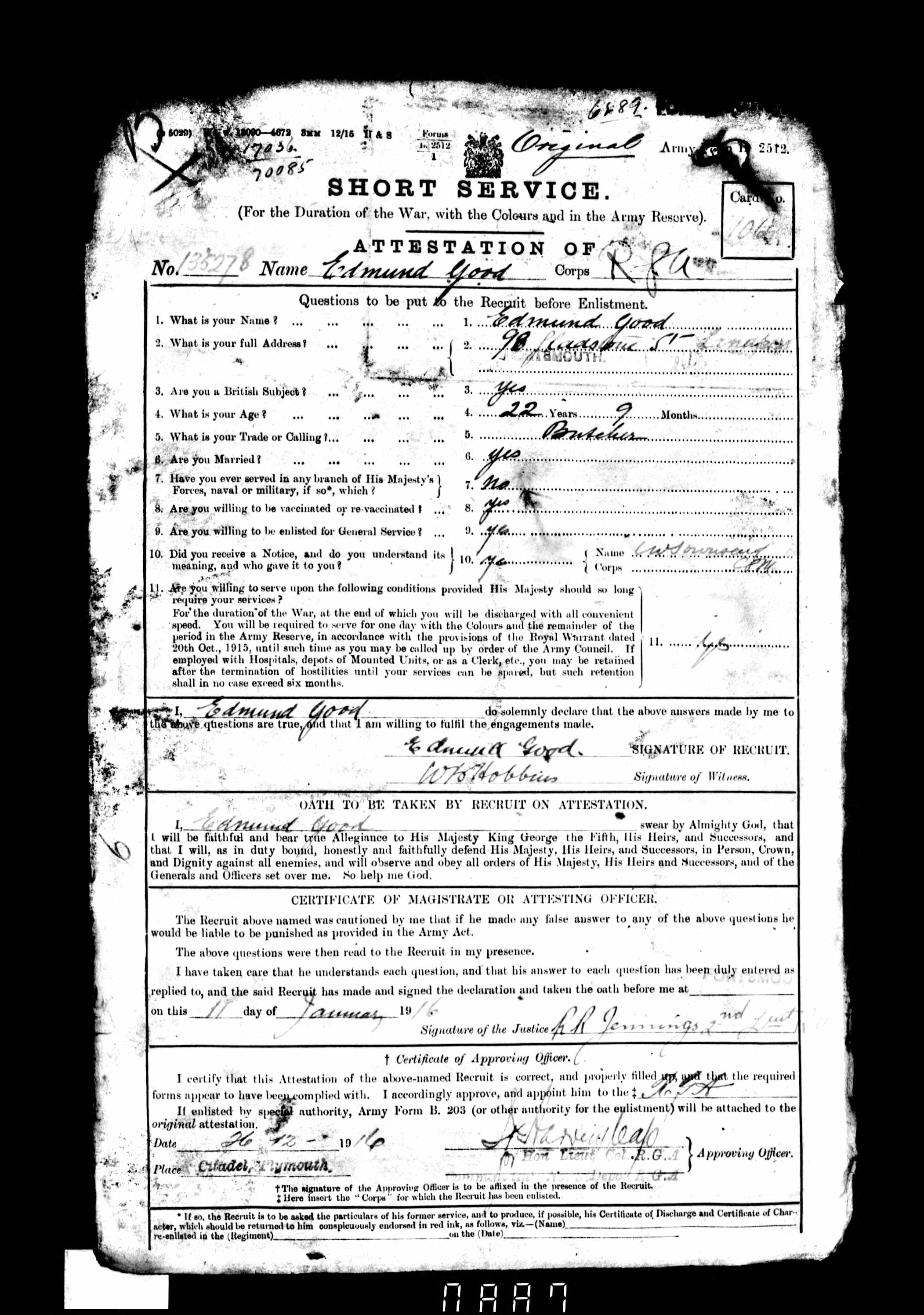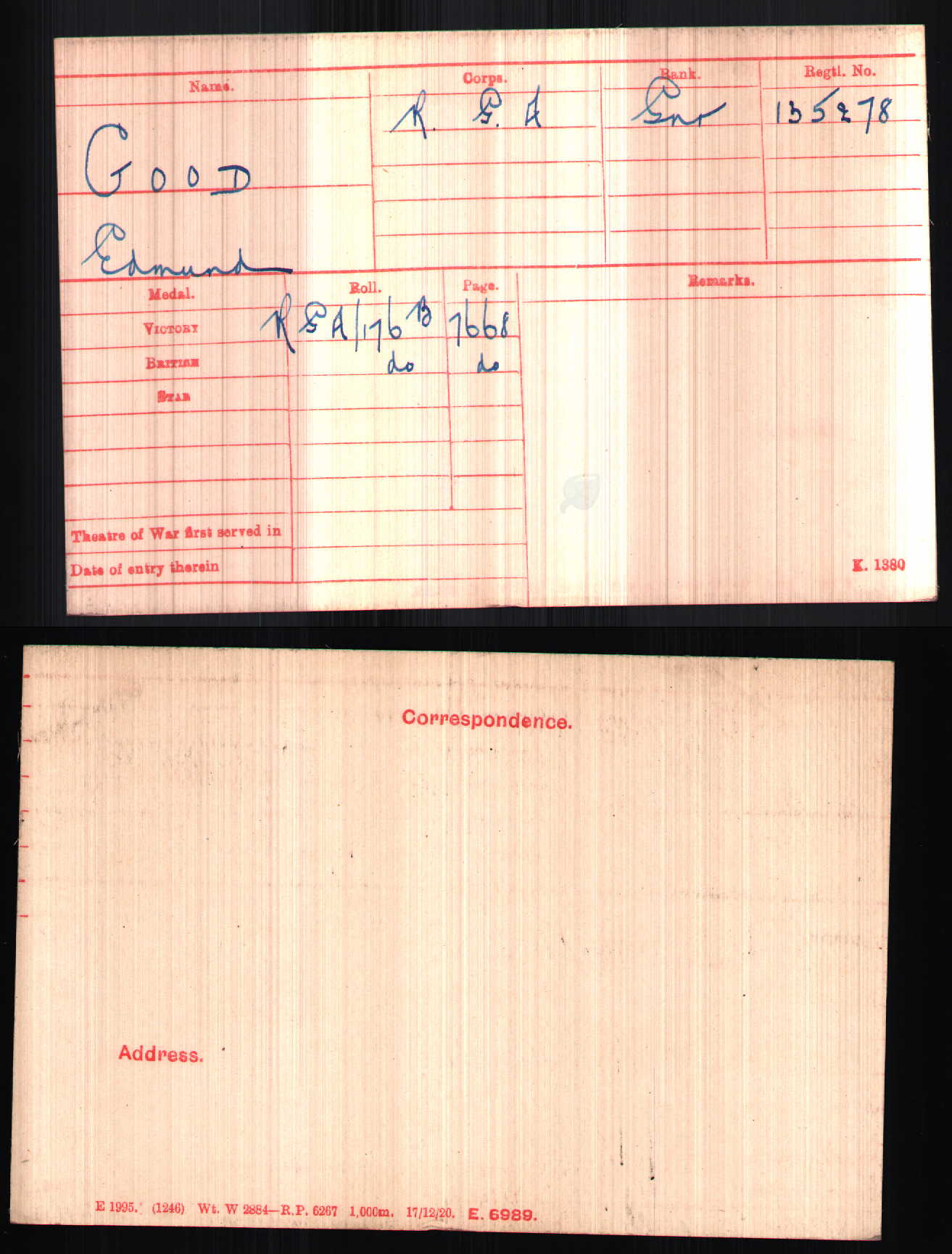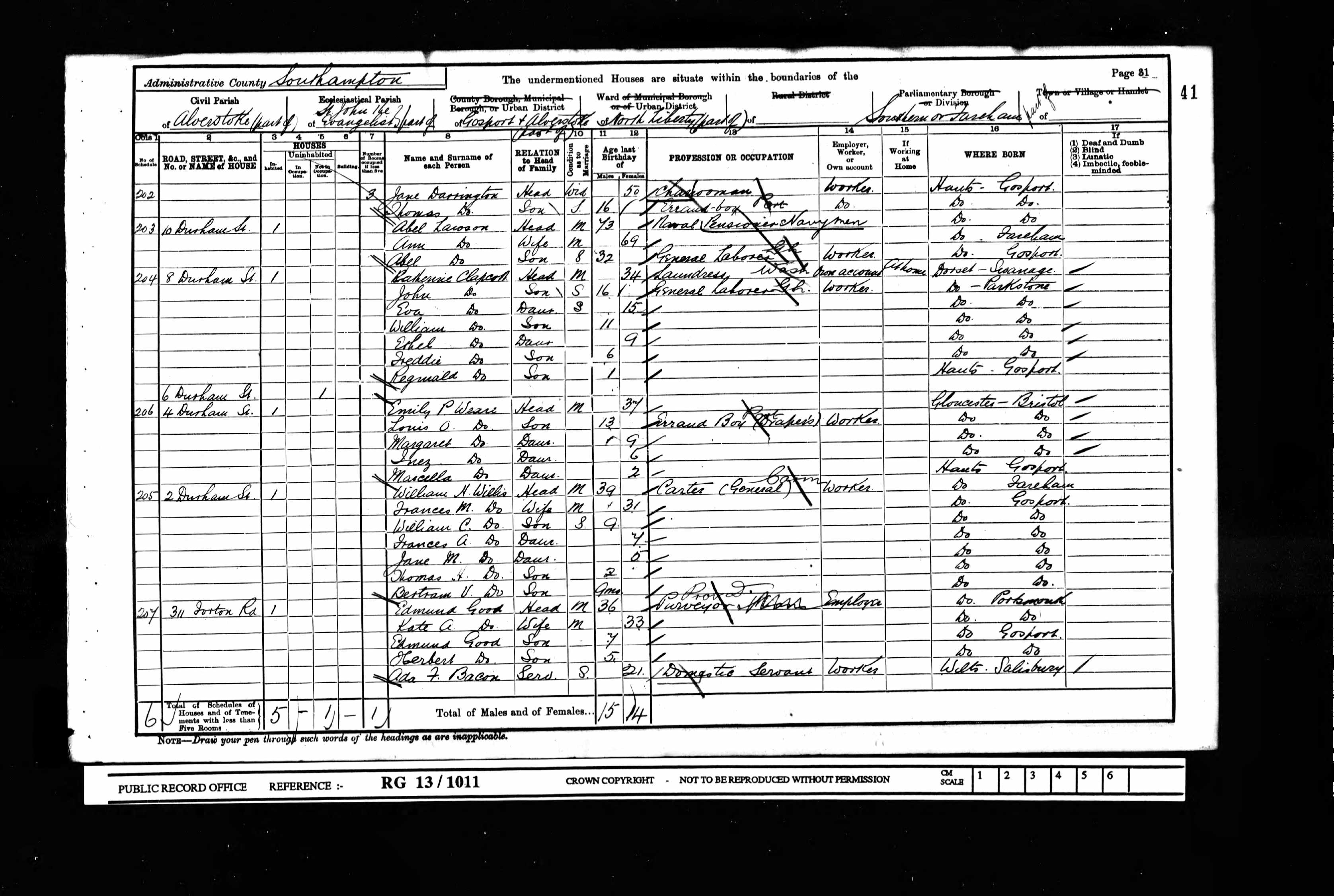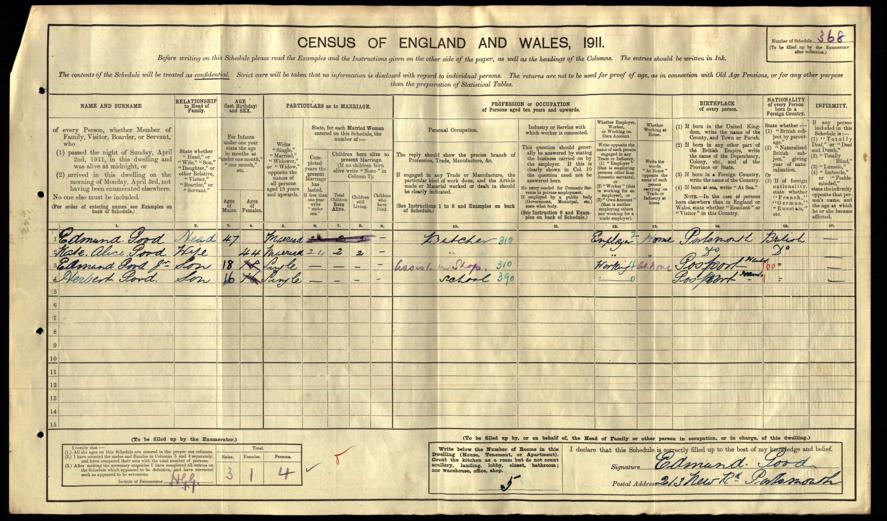 |
In Memory of |
 |
Edmund Good
Lance Bombardier
135278
Royal Garrison Artillery
who died on
Wednesday 12 March 1918. Age 24.
"Sailly Church was burnt during the open fighting of October 1914, when French cavalry and British and German infantry fought on the Lys, but from the winter of 1914-1915 to the spring of 1918 the village was comparatively untouched. It was captured by the Germans on 9 April 1918, and it remained in their hands until the beginning of September.
ANZAC Cemetery was begun by Australian units in July 1916, immediately before the Attack at Fromelles, and it contains the graves of many Australian soldiers who died in that engagement. It continued in use as a front-line cemetery until April 1918 and was used by German troops for the burial of Commonwealth soldiers during the following summer.
ANZAC Cemetery contains 320 Commonwealth burials of the First World War. 62 of the burials are unidentified but there are special memorials to seven casualtes known or believed to be buried among them, and to three soldiers buried by the Germans in Sailly Churchyard whose graves could not be located. It also contains five Second World War burials and six German graves."[from the Commmonwealth War graves site]
| The entrance gate to the ANZAC
Cemetery. Sailly-Sur-La-Lys |
Edmund's grave is located at
position III D 2. in the cemetery. His
headstone the second one in this row with the
small bush in front of it. |
135278
L/BOMBARDIER E. GOOD ROYAL
GARRISON ARTILLERY 12TH MARCH
1918 AGE 24 |
|
| Edmund's headstone |
Close-up of the top of the
headstone |
|
"EVER IN
OUR MEMORIES"
"HONNEUR ET
PATRIE" |
Third
cousin, once removed, Kenneth Scott, at the
grave of Edmund in October 2013. |
| A view from the
front of the cemetery. Edmond's grave is visible
in the fourth (D) row second grave in from the
center aisle with the small bush in front of it. |
A view of the
front of the cemetery and the memorial cross
taken from the fourth (D) row near Edmund's
grave. |
[the record of Edmund Good on the Commonwealth War Grave Commission website]
The Military Record of Edmund Good
Edmund was brought into the army under the provisions
of a conscription act during World War I. Soldiers so
enrolled filled out an attestation paper. While most
of these papers were lost during bombing in WWII, that
of Edmund has survived:

Edmund was a Lance Bombardier
(Acting corporal) in the Royal Garrison Artillery
(RGA) at the time of his death. The RGA was formed as
a branch of the Royal Artillery to handle the larger
coastal guns around the empire, in contrast the the
Royal Horse Artillery (RHA) which was the mobile
artillery with smaller guns that acted in direct
support of the infrantry.
Henceforth the artillery would be positioned well behind the infantry battle line, firing at unseen targets, at co-ordinates on a map calculated with geometry and mathematics. As the war developed, the heavy artillery and the techniques of long-range artillery were massively developed. The RGA was often supported by the Royal Flying Corps (RFC) who had devised a system where pilots could use wireless telegraphy to help the artillery hit specific targets. The RFC aircraft carried a wireless set and a map and after identifying the position of an enemy target the pilot was able to transmit messages such as A5, B3, etc. in morse code to a RFC land station attached to a heavy artillery units, such as Royal Garrison Artillery Siege Batteries." [source: wikipedia]
All soldiers have a military file and these files are kept by the national government. Sadly, during attacks in WWII, the personnel records of most WWI soldiers were destroyed. I have searched without luck the remaining records and the file for Edmund is not among them. This greatly limits the amount of information available concerning his military experience. We can summarize what we have in the following short list:
- He enrolled on 11 January 1916 under the conscription act.
- He was a lance bombardier in the
Royal Garrison Artillery at the time of his death
- He died on 12 March 1918, just
prior to the German spring offensive
- He is buried at the ANZAC
Cemetery in Sailly-Sur-La-Lys
 |
The
medals awarded to Edmund Good The Victory Medal The British War Medal These medals were awarded to all who served overseas during the war. The fact that he did not receive the 1914-15 star indicates he did not report overseas before the end of 1915. .[source: Ancestry.com which provides access to records of the National Archives of the U.K.] |
The Military Life of Edmund Good
I have not yet located any records which would indicate which unit(s) he was attached to, and consequently cannot view the operational records of such units to determine his locations in France or if he was in action at the time of death. The fact that he has a known grave located near a field hospital area indicates that he likely died which undergoing medical treatment. Possible causes of this could be from counter battery fire or a firing accident which in action and alternatively from illness (possibly from the flu epidemic of 1918). |
| This
satellite view shows the location of the
Sailly-Sur-La-Lys cemetery [yellow pin] where
Edmund's grave is located. The front lines prior
to the German attack in the spring of 1918 had
been in the Armentieres area with Estaires being
a well know rear area communications center. The
spring German offensive started on 21 March
shortly after the time of Edmund's death. |
Edmund's Childhood
Edmund was born in the second quarter of 1893 in Alverstoke, [source FreeBMD.org.uk website and census records] the son of Edmund and Kate Alice Good who were butchers. One or more photographs exist of Edmund's parents and hopefully there will be one of the parents with their two boys.
 |
| Edmund is a 7 year old boy living
at 311 Forton Rd. Gosport. The occupation of
Edmund's father is not clear from the entry,
but he is an employer. From family knowledge
we know he was a butcher. The mother is named
Kate. Edmund has a brother 2 years younger
than he. |
 |
Marriage
In the last quarter of 1915, Edmund married Gertude May Holiday in Portsmouth. This was a wartime marriage and so, even though he was not yet enlisted, it likely was a subdued event. However one would hope that perhaps there is a photograph somewhere of this wedding.[source FreeBMD]Edmund and Gertrude had at least one child, a daughter Katie (presumably named after Edmund's mother) born in the first quarter of 1917 [source FreeBMD] A search on FreeBMD does not reveal any other children of this union.
Gertrude remarried in the first quarter of 1923 to Edwin Hartley and they lived at the time of the setting of Edmund's headstone, at 40, Munster Rd., North End, Portsmouth. [source FreeBMD]
Credits
- Carole Jarmon a great niece of Edmund's for alerting me to his service and death in WWI and information on his child Katie
- The Commonwealth War Graves for their on-line service which provided information on Edmund's grave and Edmund's wife.
- FreeBMD which provided records for the marriage of Edmund to Gertrude May Holiday and her subsequent marriage to Edwin Hartley.
- The unknown passerby who was kind enough to take my photo at Edmund's grave.
- Ancestry.com which provided
access to attestation, war medal and census records
for Edmund
ŠKenneth Scott and others 2013
contact: ken at kenscott.com